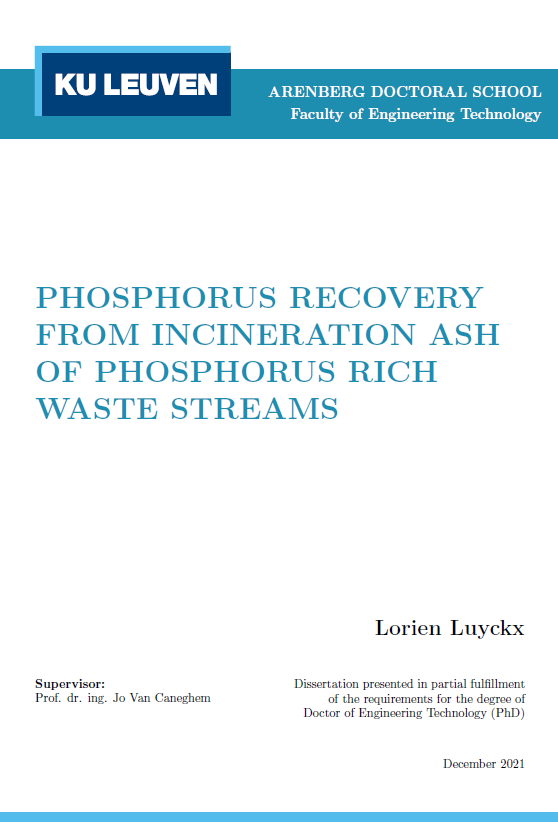Lorien Luyckx (ChEMaRTS-SIM² KU Leuven) obtained her PhD for her work on the extraction of phosphorus – a critical raw material – from biowaste incineration ash, in view of its recovery and reintroduction into the phosphorus cycle.
Phosphorus (P) is an essential nutrient for all living organisms, including humans. Currently, P used in fertilisers and animal feed is largely extracted from non-renewable phosphate rock of which reserves are depleting.
Therefore, to meet future P demands, it is imperative to recover P from alternative sources. In her PhD research, Lorien Luyckx focused mainly on sewage sludge, because it cannot be recycled directly, e.g. as a fertiliser, due to its heavy metal content exceeding legal limit values. The starting point of the research was the P-rich ash remaining from sewage sludge incineration.
Experimental results
Mineral and elemental ash characterisation and DoE extraction experiments showed that the ash composition and ash mineralogy, type of extraction liquid (i.e. inorganic acid, organic acid, alkaline solution, chelating agents), extraction liquid concentration (0.1 – 0.5 N), liquid/solid (L/S) ratio (10 – 50 ml/g ash) and contact time (10 – 120 min) all affected P and heavy metal extraction from sewage sludge ash.

Incineration experiments showed that the temperature (550 – 1100 °C) at which sewage sludge is incinerated affects the P minerology and the related P and heavy metal (co)extraction. An incineration temperature in the range of 800 – 850 °C offered the best trade-off between high P extraction and low heavy metal co-extraction. The co-extraction of heavy metals could be further reduced by adding aluminium chloride, iron(III) chloride, magnesium chloride or aluminium sulphate to the sewage sludge prior to incineration. This had a minimal effect on the P extraction efficiency.
Societal relevance
This research is of high relevance to P industry stakeholders. It indicates that it is technologically feasible to efficiently extract P from incineration ash of P-rich biomass waste streams with minimal co-extraction of heavy metals.
However, further research should investigate the purification of the obtained P extract (heavy metal removal) and the final precipitation of P compounds for specific applications. This is the subject of a recently started PhD project in the ChEMaRTS research group.
Reference to the PhD dissertation and publications Dr. Lorien Luyckx
- Full text of PhD: https://lirias.kuleuven.be/handle/123456789/685899
- Luyckx, L., Van Caneghem, J. (2021). Recovery of phosphorus from sewage sludge ash: Influence of incineration temperature on ash mineralogy and related phosphorus and heavy metal extraction. Journal of Environmental Chemical Engineering, 9 (6), Art.No. 106471. doi: 10.1016/j.jece.2021.106471 Open Access
- Luyckx, L., Sousa Correia, D.S., Van Caneghem, J. (2021). Linking Phosphorus Extraction from Different Types of Biomass Incineration Ash to Ash Mineralogy, Ash Composition and Chemical Characteristics of Various Types of Extraction Liquids. WASTE AND BIOMASS VALORIZATION, 12 (9), 5235-5248. doi: 10.1007/s12649-021-01368-3 Open Access
- Luyckx, L., Geerts, S., Van Caneghem, J. (2019). Closing the phosphorus cycle: Multi-criteria techno-economic optimization of phosphorus extraction from wastewater treatment sludge ash. Science Of The Total Environment, 713, Art.No. 135543. doi: 10.1016/j.scitotenv.2019.135543 Open Access
- Luyckx, L., de Leeuw, G.H J., Van Caneghem, J. (2019). Characterization of poultry litter ash in view of its valorization. Waste and Biomass Valorization, 11 (10), 5333-5348. doi: 10.1007/s12649-019-00750-6 Open Access
Acknowledgements
The research leading to these results has received funding from the Research Foundation – Flanders (FWO) – project number 1S08418N.
(This post was prepared by Prof. Jo Van Caneghem and further edited by Dr. Peter Tom Jones)
.jpg)





